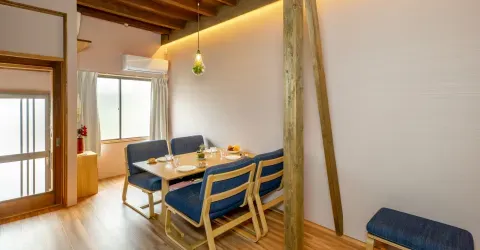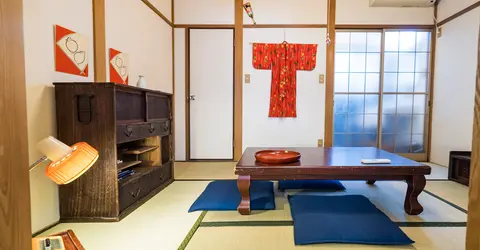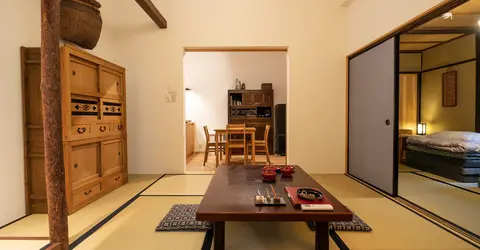Fushimi Kyoto Walk
- Fushimi History
- Chokenji
- Gekkeikan Okura Kinenkan
- Teradaya
- Saiganji
- Kizakura Kinenkan
- Torisei
- Gokonomiya Shrine
- Accommodation in Fushimi
- Fushimi Access
- Fushimi Map
Fushimi Walk, Kyoto 伏見
This self-guided walking tour of Fushimi in Kyoto is based on Judith Clancy's excellent book Exploring Kyoto: On Foot in the Ancient Capital. An updated version of this super walking guide to Kyoto was released in 2018.
This walk is somewhat off-the-beaten-track Kyoto and may not appeal to those wishing to "do" the major temples in Kyoto on a short, first visit. It should appeal to those visitors who have already seen the "sights" and wish to explore a little deeper into a quieter, less crowded, neighborhood Kyoto.
The map in Clancy's book is adequate but you may wish to supplement it with the Google map at the bottom of this page.

The long, traditional front of the Gekkeikan Sake Brewery, Fushimi, Kyoto
The walk starts from Chushojima Station on the Keihan Line and returns to the station. Visitors could also extend the walk by going on to Fushimi Castle and Fushimi Inari Shrine to the north east, either on foot or by train.
In all, the walk takes just a few hours but can also include lunch and stops in the various sake breweries that Fushimi is most famous for now, along with the several Kyoto arts and crafts shops, and souvenir stores encountered along the way.

Traditional public bath house (sento) near Chushojima Station, Fushimi, Kyoto

Chokenji Temple, Chinese-style gate, Fushimi, Kyoto
Fushimi History
Fushimi was an important and prosperous river port in the Edo Period connecting Kyoto and Osaka and then on to Edo (present-day Tokyo). Goods and people flowed in and out of Fushimi. Inns such as the historic Teradaya Inn were built to house some of the many travelers who used this important route.
The history of Fushimi as a river port begins with the warlord Toyotomi Hideyoshi who built Fushimi Castle between 1592-1594 and it was here the great warlord passed away in 1598. Materials for the construction and decoration of the castle flowed in to the area along the Uji, Kamo, Katsura and Yodo rivers. After the Battle of Sekigahara in 1600 and establishment of the Tokugawa shogunate, the new regime dismantled the castle and distributed many of its buildings and gates among the city's temples.
However, Fushimi's renown water and sake breweries meant the area continued to thrive as both a production and logistics center. Rice was brought in by barge and sake shipped out to Osaka and then on to Edo and the rest of the country.
The area around what is now Chushojima Station became an entertainment quarter in the Edo era and Chokenji Temple, our first stop, houses a wooden image of Benten, one of the seven lucky gods of Japan (Shichifukujin), the goddess of among other things, water and music.
With the opening of various ports on the coast in the Meiji Period such as Kobe and Yokohama and the construction of Japan's first railways, river traffic in and out of Fushimi declined. However, the more than 20 sake breweries located in Fushimi still continue to produce some of Japan's most-loved tipples.

Sake casks, Chokenji Temple, Kyoto

Chokenji Temple, Chinese-style gate, Fushimi, Kyoto
Chokenji 長健寺
Chokenji Temple still stands in a modern-day entertainment area of sorts full of "snacks" and other night-time bars.
Visitors enter Chokenji (Tel: 075 611 1039) through a Chinese-style gate flanked with cherry trees brought from the Chokenji's parent temple, Daigoji. Huge ginkgo trees also stand within the temple's walls.
Sake casks, donations from local businesses, are also prominent within the grounds. A round, stone pit in the temple is used for the ritual burning of gomagi prayer sticks in festivals held throughout the year. The biggest one is held in July. Chokenji also sells an bizarre amulet in the shape of a clam, a sexual reference in Japan and a nod to the area's past as an historic red light district.

Gekkeikan Sake Brewery, Fushimi, Kyoto
Gekkeikan Sake Brewery 月桂冠大倉記念館
Gekkeikan Sake Brewery (Gekkeikan Okura Kinenkan) has over 6,000 tools and implements related to sake brewing and production. The buildings on the campus as well are fascinating and include a reproduction of the original Gekkeikan office. Also on display are photographs of the brewery in times gone past and the work clothes used by the brewers. Visitors can also learn about the sake brewing process in a mini-brewery and buy sake and sake-related products in the shop including sake cups and flasks and even bath salts made from sake lees. The grounds include a 50 meter deep well that provides some of the water used in the brewing process. Look out for a traditional sakabayashi - a ball of cedar twigs associated with sake producers nationwide.
Across the road from the Gekkeikan Okura Kinenkan near the car park and Shorinin Temple is a sign pointing out the Fushimi Jesuit Church that once stood here. This was in fact the residence of the Christian daimyo Takayama Ukon (1552-1615). Due to the persecution of the Christian faith in the early Edo era, Ukon was forced to flee Japan in 1614 and died in Manila in The Philippines the following year.

Teradaya Inn in Fushimi, Kyoto

Large chochin lantern outside the historic Teradaya Inn in Fushimi, Kyoto
Teradaya Inn 寺田屋
The historic Teradaya Inn is associated with two violent incidents in the late Edo Period. In 1862 nine Satsuma (present-day Kagoshima Prefecture) samurai were killed in a fratricidal struggle. Four years later in 1866, Sakamoto Ryoma, narrowly escaped assassination at the hands of Tokugawa officials, thanks to the prompt action of his lady friend and future wife Oryo.
Nowadays the Teradaya Inn serves both as a museum dedicated to Ryoma and its rich history and also as a functioning inn. The many small wood and tatami-floored rooms of Teradaya are packed with furniture, calligraphy scrolls, Japanese swords, paintings, books and photographs.
The original Teradaya Inn was burnt down in the Battle of Toba-Fushimi in 1868. The present building is from a later date.

The oil covered statue of Jizo at Saiganji Temple, Fushimi, Kyoto
Saiganji 西岸寺
The next temple on the Fushimi walk is Saiganji. Saiganji belongs to the Jodo sect of Japanese Buddhism. A fairly nondescript temple, Saiganji does, however, have two important statues. The Main Hall (Hondo) has an image of Amida and the hall off the street houses a Kamakura Period image of Aburakake Jizo ("Oil Pouring Jizo").
The story surrounding the image is interesting. One day a merchant tripped and fell spilling his load of valuable sesame oil. He scooped what was left of his precious oil and offered it to a statue of Jizo. Later the merchant prospered and became wealthy. As a result businesses and shops (especially those in the oil trade) pour oil over the statue as an offering for successful trading or leave large cans of oil. The present day temple structures date from 1978.

Kizakura Kappa Country, Fushimi, Kyoto

Kizakura Kappa Country, Fushimi, Kyoto
Kizakura Kappa Country 黄桜記念館
The elegant, wooden buildings of Kizakura Kappa Country are a renovated sake warehouse. The complex now houses a gallery restaurant, shop, as well as a sake and craft beer brewery.
The gallery traces the history of the area using wall panels, dioramas and realia. On display are antique sake bottles and wooden production implements. Across the road in another building is a 60 meter deep well gushing out clear, delicious water. Locals come on their bicycles with plastic bottles to collect the water every day.
Torisei 鳥せい
Torisei (Tel: 075 622 5533) is a popular yakitori (skewered chicken) restaurant just up the street from Kizakura Kappa Country. The restaurant is housed in a pleasant, traditional, wooden building. Walking west towards Fushimi-Momoyama Station is a traditional shotengai arcade - a covered shopping street full of cafes, eateries and stores.
Uosaburo (Tel: 075 601 0061; 11.30 am - 2 pm, 5 pm-7.30 pm) is a traditional kaiseki restaurant mentioned in Judith Clancy's book and dates back to 1764. The building, once part of a feudal lord's residence, bears the scars, in the shape of bullet holes, from the unrest in the area at the end of the Edo Period. Prices are fairly high and a reservation may be necessary. The food, matched with the local sake, is superb. Contact us if you need help in reserving this restaurant or any other in Japan.

Torisei, Fushimi, Kyoto
Gokonomiya Shrine 御香宮神社
Gokonomiya Shrine is a large shrine on your left as you pass under the Kintetsu railway tracks. The spacious grounds are full of smaller sub-shrines dedicated to a variety of kami. The shrine is famous for its fragrant spring reflected in the kanji name of the shrine. Hideyoshi Toyotomi, himself, is said to have sampled its healing water.
Many of the shrine's buildings have been recently repainted in brilliant color. There is also an impressive Noh stage and a number of torii gates.
The area around the shrine saw fighting during the Battle of Fushima-Toba in 1868.

Gokonomiya Shrine, Fushimi, Kyoto

Torii gates, Gokonomiya Shrine, Fushimi, Kyoto
Accommodation in Fushimi
This area of Kyoto does not have an over-abundance of hotels but there is a growing number of private rentals and guest houses. One recommended place to stay in the area is Urban Inn Fushimi.

Keihan Chushojima Station, Fushimi, Kyoto
Access: Getting To Fushimi
Take the Kintetsu Line to Momoyama-goryo-mae from Kyoto Station, the JR Nara Line to Momoyama Station or the Keihan Main Line to Chushojima Station.
This guide starts from Chushojima Station reached from Sanjo Keihan Station which is also on the Tozai Line of Kyoto subway. You can pick up an area map (in Japanese) at the station.
From Kyoto Station the following buses: 81, 105 and 南5 run to Chushojima Station.
Fushimi Map
Books on Japan Travel
Fushimi Kyoto Walk: Fushimi in south east Kyoto is known for its sake brewing. The area was an important river link to Osaka in the Edo Period and makes for a pleasant half-day walk with lunch.






























